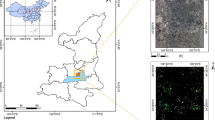Abstract
Since the construction of Sponge City in China, the research on the construction of Sponge City has mostly focused on the engineering level, and the research on the selection, function and configuration of plants has lagged behind, resulting in unreasonable plant selection, lack of “localization” of plant design, and lack of systematic and targeted consideration and design of plant landscape configuration, which has restricted the construction and development of Sponge City to some extent. Mian city can reduce urban waterlogging, improve the utilization rate of water resources, and meet the requirements of green environmental protection development in China. Through analysis, the functions of plants in Sponge City are summarized as landscaping and ecological protection. Based on the clues of meeting these two functions, combined with in-depth learning, this paper proposes the principles of plant selection and configuration under the concept of Sponge City, which provides a theoretical basis for the selection of plants in the construction of Sponge City. The paper summarizes the plants that can be used in sponge cities, and draws the common plant configuration patterns in low impact development facilities during the research process, providing relevant theoretical basis and experience for further construction of sponge cities in China.
Access this chapter
Tax calculation will be finalised at checkout
Purchases are for personal use only
Similar content being viewed by others
References
Li, Q., Wang, F., Yu, Y., Huang, Z., Li, M., Guan, Y.: Comprehensive performance evaluation of LID practices for the Sponge City construction: a case study in Guangxi, China. J. Environ. Manage. 231, 10–20 (2019) (In Chinese)
Jiang, C., Li, J., Hu, Y., Yao, Y., Li, H.: Construction of water-soil-plant system for rainfall vertical connection in the concept of Sponge City: a review. J. Hydrol. 127327 (2021)
Wang, H., Mei, C., Liu, J.: Systematic construction pattern of the Sponge City. J. Hydraul. Eng. 48(9), 1009–1014 (2017)
Zhao, B., Du, Y., Ren, L., Wang, J.: Preparation and performance of epoxy resin permeable bricks for Sponge City construction. J. Appl. Polym. Sci. 137(34), 49008 (2020) (In Chinese)
Yang, P., Zhao, Z.X., Li, Z.C., Wang, Y.H.: Experimental study on long-term performance of new urban green space soil for Sponge City construction. Urban For. Urban Greening 58, 126906 (2021)
Wang, Y., Liu, Z., Wang, G., Xue, W.: Cellular automata based framework for evaluating mitigation strategies of Sponge City. Sci. Total Environ. 796, 148991 (2021)
Chen, L., Wang, Y.: Study on plant configuration and planning of landscape architecture in coastal cities. J. Coast. Res. 115, 17–20 (2020) (In Chinese)
Guo, F., Gao, Z.: Sponge City plant planning and urban construction based on high-resolution remote sensing images. Arab. J. Geosci. 14(12), 1–15 (2021)
Helliwell, M., Thomas, E.J., Whitehouse, D.L.: Reduktion der Lärmbelästigung durch Geschwindigkeitsmessanlagen? Eine Interventionsstudie in Lübeck. Das Gesundheitswesen (Deutsch) 22, 13563 (2017)
Yin, D., Chen, Y., Jia, H., Wang, Q., Chen, Z., Xu, C., et al.: Sponge City practice in China: a review of construction, assessment, operational and maintenance. J. Clean. Prod. 280, 124963 (2020) (In Chinese)
Author information
Authors and Affiliations
Corresponding author
Editor information
Editors and Affiliations
Rights and permissions
Copyright information
© 2023 The Author(s), under exclusive license to Springer Nature Singapore Pte Ltd.
About this paper
Cite this paper
Wang, H., Zhao, X., Chen, J. (2023). Research on Plant Allocation of Sponge City Construction Based on Deep Learning. In: Patnaik, S., Kountchev, R., Tai, Y., Kountcheva, R. (eds) 3D Imaging—Multidimensional Signal Processing and Deep Learning. Smart Innovation, Systems and Technologies, vol 348. Springer, Singapore. https://doi.org/10.1007/978-981-99-1145-5_19
Download citation
DOI: https://doi.org/10.1007/978-981-99-1145-5_19
Published:
Publisher Name: Springer, Singapore
Print ISBN: 978-981-99-1144-8
Online ISBN: 978-981-99-1145-5
eBook Packages: Intelligent Technologies and RoboticsIntelligent Technologies and Robotics (R0)




